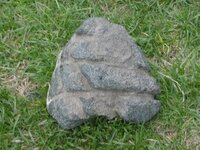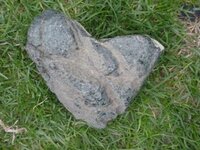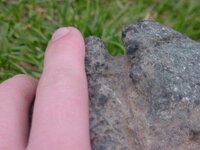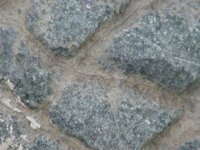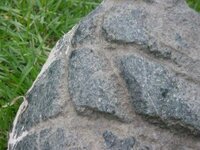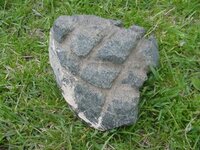Sandsted
Sr. Member
- Apr 20, 2006
- 275
- 1
I've recently found this stone. At first, only being able to see a corner and one rut in the stone, I thought it was some type of freak water erosion. And I thought it was rather unique so I dug it up. But then I saw that it had a few more ruts so I thought it was hit by a disc or plow or something. But then as I got it fully out of the ground I found that these carvings go all the way around the stone and even if it were possible for a disc to carve consistently all the way around the stone, it would have had to repeatly hit it. Over and over again.
So I've concluded that it must be something else.
The only thing I can think of is some type of Native American tool or weapon.
But it doesn't look to be much use to my eye, but then I don't know a whole lot of Native American culture.
It has very deep carvings, and in each of them there is a thin line down the center.
It's rather large stone to be used in the matter of which I assume. It looks to be tied to something and it's measurements are about 19 cm wide, 15 cm in length and about 10 or 11 cm high.
I've included pictures to see the over shape of the stone. It also has on one side what appears to be a mostly natural cut into the stone so it makes tent sort of shape when lieing on the ground. (see pictures)
I found it on May 6th in Western (centralist...little North) Minnesota.
Any info or insites would be greatly appreciated.
So I've concluded that it must be something else.
The only thing I can think of is some type of Native American tool or weapon.
But it doesn't look to be much use to my eye, but then I don't know a whole lot of Native American culture.
It has very deep carvings, and in each of them there is a thin line down the center.
It's rather large stone to be used in the matter of which I assume. It looks to be tied to something and it's measurements are about 19 cm wide, 15 cm in length and about 10 or 11 cm high.
I've included pictures to see the over shape of the stone. It also has on one side what appears to be a mostly natural cut into the stone so it makes tent sort of shape when lieing on the ground. (see pictures)
I found it on May 6th in Western (centralist...little North) Minnesota.
Any info or insites would be greatly appreciated.


